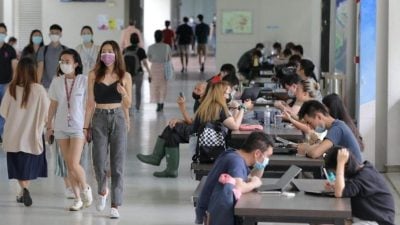
In conjunction with the World Diabetes Day on 14 November, let’s remind ourselves to maintain a healthy and active lifestyle in order to prevent diabetes mellitus.
According to the National Health Morbidity Survey in 20191, the prevalence of diabetes among Malaysian adult population was 18.3%, with 9.4% known and 8.9% of unknown diabetes.
The prevalence has been in an increasing trend from 11.2% in 2011 and 13.4% in 2015.
Since the COVID-19 pandemic in March 2020, our government has introduced a series of movement control orders ranging from complete to partial lockdowns.
The 2019 NHMS reported that about one quarter of our adult population were physically inactive.
However, with the lockdown during the past one and a half years, there may be an increase in the proportion of sedentary lifestyle among our population.
A systemic review reported that increase in sedentary behaviors was found among the adult participants during the COVID-19 pandemic2.
Our population who are now allowed to return to work on site and with the opening of almost all sectors including parks and sports facilities, should make good use of these facilities by incorporating physical activities in their working life.
They need to have a work life balance with physical activities included as one of their daily tasks or have it incorporated in their daily chores.
Despite the fact most states have moved to phase four of the National Recovery Plan currently, a number of employees are still working from home in compliance with the standard operating procedures.
Consequently, a long working duration from home with prolonged sitting in front of a computer or laptop, results in the continuation of a sedentary lifestyle.
Sedentary lifestyle with long periods of sitting down, either working or during leisure time, may cause an increase in body weight and changes in the body’s metabolism such as insulin resistance that could lead to type 2 diabetes mellitus3.
Hence, it is challenging for these working adults to alter their sedentary behaviors to an active lifestyle.
To resolve this issue, the followings recommendations involving a top-down collaboration from policymakers, employers, municipals and individuals in the interpersonal and intrapersonal levels is required4:
1. Policymakers: government to disseminate relevant information via media platforms about the detrimental effect of long-term sedentary lifestyles on health.
2. Employers and municipals in the neighborhood: employers are encouraged to provide the sit and stand work stations for employees to reduce prolonged sitting. On the other hand, municipals should improve the available recreational parks, hence encouraging leisure physical activities among the residents.
3. Interpersonal: Social support from colleagues in the form of encouraging each other to take short stretching breaks during long hours of sitting. Family members and friends can also organize step-count competitions which discourage sedentary lifestyle at leisure such as lying down when watching television programs or playing computer games instead of opting for walking or jogging with family members and friends in recreational parks.
4. Intrapersonal: As for the individuals, finding a physical activity that they enjoy most will motivate them to continue adhering to it, thereby slowly changing their sedentary behavior while working from home. Those physical activities can be as simple as gardening, singing and dancing with some favorite music, playing with kids or pets.
With COVID-19 still an ongoing disease worldwide as well as in Malaysia, the working adults should not only comply with the standard operating procedures in workplaces or public places, we also need to stay physical active to prevent type 2 diabetes mellitus which is also one of the risk factors for severe COVID-19.
References:
1 Ministry of Health. National Health & Morbidity Survey, Malaysia. 2019.
2 Stockwell S, Trott M, Tully M, Shin J, Barnett Y, Butler L, et al. Changes in physical activity and sedentary behaviours from before to during the COVID-19 pandemic lockdown: a systematic review. BMJ Open Sport & Exercise Medicine. 2021;7(1):e000960.
3 Wilmot EG, Edwardson CL, Achana FA, Davies MJ, Gorely T, Gray LJ, et al. Sedentary time in adults and the association with diabetes, cardiovascular disease and death: systematic review and meta-analysis. Diabetologia. 2012;55(11):2895-905.
4 Ricci F, Izzicupo P, Moscucci F, Sciomer S, Maffei S, Di Baldassarre A, et al. Recommendations for physical inactivity and sedentary behavior during the coronavirus disease (COVID-19) pandemic. Frontiers in public health. 2020;8:199.
(Ng Yit Han, PhD candidate and Professor Dr Moy Foong Ming, Department of Social & Preventive Medicine, Faculty of Medicine, Universiti Malaya.)
ADVERTISEMENT
ADVERTISEMENT








































